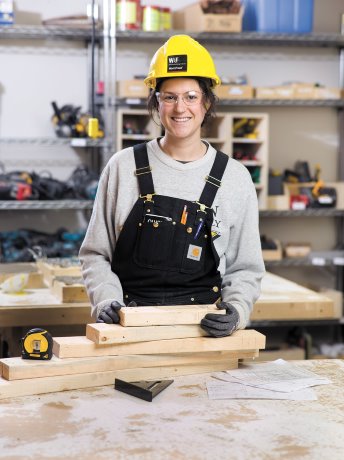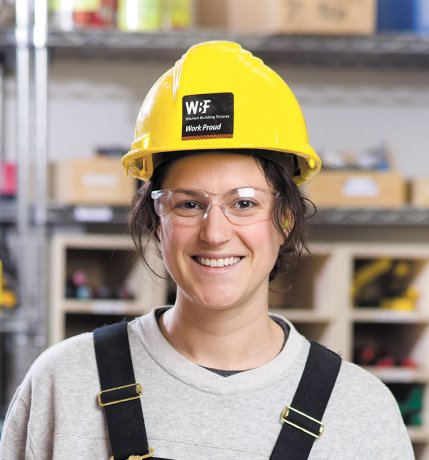According to a 2016 BuildForce Canada report, the Canadian construction industry employs about 12 per cent women and 88 per cent men.
Nearly three-quarters of women employed in construction work in such off-site occupations as business administration, management and sales. Women’s share of onsite employment is only about four per cent.
Rosemary Sparks, the recently retired executive director of BuildForce Canada, thinks that figure should be higher.
"There are many negative stereotypes about the ability of women in the trades to do the job," Sparks said. "The stereotypes are one of the reasons why there aren’t more women working onsite."
In fact, she said, many women are more than able to do the work.
"They have the size, stamina and desire to do well in the industry," Sparks said.
Most Canadian women making career choices today are unaware of the construction industry and the benefits a career there offers, she added.
"The industry has changed a lot," Sparks said. "For example, it is more safety-conscious now. We don’t want workers, whether they’re male or female, injuring themselves."
Mike McKenna, executive director of the BC Construction Safety Alliance (BCCSA), said the construction industry would be better if more women worked in it.
"Organizations perform better when there is a more equal balance of men and women working in them," said McKenna.
Among its responsibilities, BCCSA qualifies traffic control persons (TCPs, or flaggers) and designates National Construction Safety Officers (NCSOs) in B.C.
Although three out of four flaggers and one out of two NCSOs are women, McKenna said there should be more women in other construction occupations.
"Women have good organizational, planning and communication skills," McKenna said. "Women are able to communicate in a way that makes men respond positively."
McKenna said new digital technology is enabling more components of a project to be prefabricated in a plant and assembled onsite.
"It’s opening up construction to more women because it removes some of the hard physical labour," he said. "And the industry can attract more women to it by creating a better — and cleaner — workplace environment."
Amandeep Beesla, who is the NCSO co-ordinator of the BCCSA, used to be a heavy equipment operator in the Alberta oilsands.
"I ran heavy equipment, mostly trucks and bulldozers, up in Fort McMurray when I first got there," she said.
Beesla had no formal training on the equipment.
"Everything I learned was hands on from a very early age," she said. "I’ve been around heavy equipment and machinery since childhood. I’m a third-generation trucker."
In addition to driving, Beesla conducted all pre- and post-trip inspections, fuelling and checking fluid levels. She wasn’t the only female heavy equipment operator in the oilsands, either.
"Most supervisors prefer females, as they’re easier on the equipment," Beesla stated.
"Female operators were able to anticipate tasks and equipment movement better than their male counterparts. This made for a smoother day and more efficient site."
Heavy equipment operators are also at work in British Columbia, at the Site C Clean Energy Project near Fort St. John. The Peace River Hydro Partners joint partnership between ACCIONA Infrastructure Canada Inc. and Samsung C&T Canada Ltd. holds the main civil works contract for the dam project.
"We have about 200 pieces of heavy equipment at the work site," said Steve Chaplin, Vice President, Quality, Health, Safety, Environment and Sustainability of ACCIONA.
To run the equipment, the partnership employs approximately 400 operators, of whom about 10 per cent are women.
"We are happy to hire good operators, men or women," said Chaplin. "Over the years we have seen an increase in female equipment operators and overall they are good, competent operators."
Sarina Hanschke, who is in charge of quality assurance in the BCCSA’s traffic control program, said recent developments have made it easier for women to have a career in construction.
"For example, more ergonomically-friendly tools are being made for smaller bone structures," said Hanschke. "And occupational health and safety regulations now in place encourage team-lifting and restrict individual lifting to 40 pounds."
Construction needs to develop new strategies to recruit and retain women, Hanschke said.
"For years construction workers passed on the knowledge of their craft from father to son," she said. "This generational passing of the torch led to insular recruiting strategies. Present day advertising for the industry perpetuates this by heavily gearing images and language towards men."

According to BuildForce Canada the construction industry employs about 12 per cent women and 88 per cent men.
Photo: File Photo"










Recent Comments
comments for this post are closed